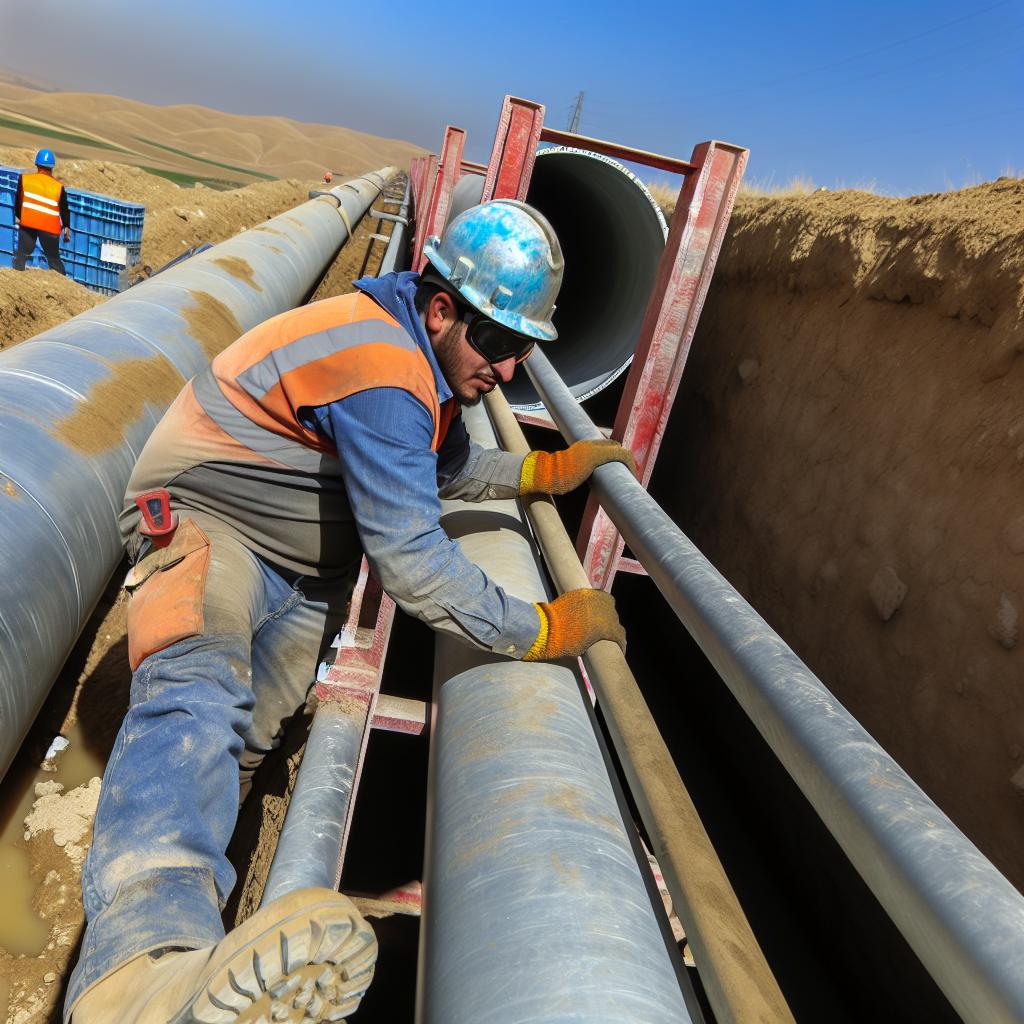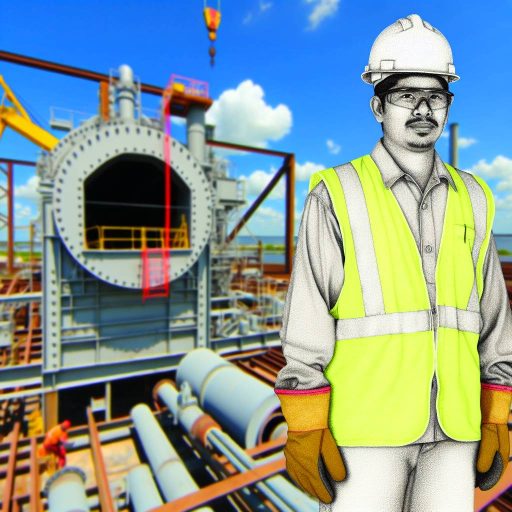Introduction:
What exactly does a pipelayer do in construction projects?
Pipelayers are responsible for installing and repairing pipelines that are crucial for the functioning of buildings or infrastructure.
The importance of pipelayers in construction projects cannot be overstated.
They play a vital role in ensuring the successful completion of projects by laying the groundwork for other tasks to follow.
Overview of the pipelayer’s responsibilities:
One of the key roles in construction projects is that of the pipelayer.
These skilled workers are responsible for the installation and maintenance of underground pipelines that carry water, sewage, gas, or oil.
Let’s dive deeper into the specific responsibilities of a pipelayer.
First and foremost, a pipelayer must carefully follow blueprints and specifications to determine the exact location and depth of where the pipes need to be installed.
This is critical to ensure that the pipelines function efficiently and effectively.
Once the location has been identified, the pipelayer is responsible for excavating the area to create a trench that will house the pipes.
This requires physical strength and the ability to operate heavy machinery such as excavators and backhoes.
After the trench has been dug, the pipelayer must then position the pipes in place.
This involves careful attention to detail to ensure that the pipes are properly aligned and have the correct grade to allow for proper flow of the material being transported.
Connecting the pipes together is another essential task of a pipelayer.
Depending on the type of material being transported, pipes may be connected using various methods such as welding, gluing, or using mechanical couplings.
Each method requires a high level of skill and precision to ensure a secure and leak-proof connection.
Additionally, pipelayers must also be knowledgeable about the different types of pipes and fittings available for construction projects.
They must be able to select the appropriate materials based on the specific requirements of the project, such as the type of material being transported, the pressure requirements, and the environmental conditions.
Another important aspect of a pipelayer’s responsibilities is to conduct tests on the completed pipeline to ensure that it is functioning properly.
This may involve pressure testing the pipes to check for leaks or performing flow tests to verify that the material is moving through the pipeline at the correct rate.
Transform Your Career Today
Unlock a personalized career strategy that drives real results. Get tailored advice and a roadmap designed just for you.
Start NowOverall, pipelayers play a crucial role in the success of construction projects by installing and maintaining the underground pipelines that are essential for the functioning of buildings, infrastructure, and utilities.
Their attention to detail, technical skills, and commitment to quality work are vital in ensuring that pipelines are installed safely and efficiently.
- Laying and positioning underground pipes according to blueprints and specifications.
- Ensuring proper alignment and grade of pipes.
- Connecting pipes using various methods such as welding or gluing.
Skills required to be a successful pipelayer:
Having the skills mentioned above is crucial for anyone aspiring to be a successful pipelayer in construction projects.
Let’s delve deeper into each of these skills to understand their importance and how they contribute to the overall success of a pipelayer.
Physical strength and stamina:
Working as a pipelayer requires a significant amount of physical strength and stamina.
The job often involves lifting and carrying heavy pipes, maneuvering equipment, and working in various weather conditions.
Without adequate physical strength and stamina, it can be challenging to perform the tasks efficiently and safely.
Pipelayers must be in good physical condition to handle the demands of the job effectively.
Ability to use various tools and equipment:
Pipelayers work with a wide range of tools and equipment to install pipes correctly.
From pipe cutters and wrenches to levels and lasers, pipelayers must be proficient in using these tools to ensure precise and accurate pipe installation.
Familiarity with different tools and equipment is essential for pipelayers to work efficiently and maintain the quality of their work.
Understanding of construction plans and drawings:
Interpreting construction plans and drawings is a key skill for pipelayers.
They need to understand the layout of the pipes, the location of utility lines, and other important details to install pipes correctly.
Without a thorough understanding of construction plans and drawings, pipelayers may make mistakes that could result in costly rework and delays in the project.
Attention to detail and precision in pipe installation:
Attention to detail is crucial for pipelayers to ensure that pipes are installed correctly and meet the required specifications.
Precision is essential when aligning pipes, connecting joints, and ensuring proper drainage.
Any mistakes in pipe installation can lead to leaks, blockages, or other issues that can compromise the functionality of the system.
Pipelayers must pay close attention to every detail to deliver high-quality work.
Gain More Insights: Physical Health Maintenance for Dockworkers
Showcase Your Business Today
Reach thousands of readers actively exploring professional services. Publish your business profile and grow your audience now.
Publish NowWhen it comes to construction projects, the role of a pipelayer is crucial for the successful installation of pipelines.
Pipelayers are responsible for laying and installing the pipes that carry water, sewage, or gas in various construction projects.
They play a significant role in ensuring the proper functioning of the pipeline system.
Importance of Proper Pipe Installation:
- Ensuring the functionality and longevity of the pipeline system
- Preventing leaks and other issues that could lead to costly repairs
- Compliance with safety regulations and environmental standards
Pipelayers are skilled workers who have expertise in reading blueprints, understanding the layout of the pipeline system, and using various tools and equipment to install pipes accurately.
They work closely with other construction workers, engineers, and designers to ensure that the pipeline system meets the project’s requirements.
Proper pipe installation is essential for the functionality and longevity of the pipeline system.
If pipes are not installed correctly, it can lead to leaks, bursts, and other issues that could result in costly repairs and downtime.
Pipelayers ensure that pipes are laid out and connected properly to prevent any potential problems down the line.
Leaks in pipelines can not only be expensive to repair but can also pose serious safety risks to workers and the surrounding environment.
Pipelayers are trained to detect and address any issues that may arise during the installation process to prevent leaks and ensure a safe working environment.
In addition to ensuring the functionality of the pipeline system, proper pipe installation also involves compliance with safety regulations and environmental standards.
Pipelayers must follow strict guidelines and regulations to prevent accidents, protect the environment, and meet the project’s requirements.
Overall, the role of a pipelayer in construction projects is essential for the successful installation of pipelines.
They play a vital role in ensuring the functionality, longevity, and safety of the pipeline system.
By following proper installation practices and regulations, pipelayers contribute to the success of construction projects and the overall integrity of the pipeline system.
Learn More: How to Land a Job as a Warehouse Worker
Collaboration with other construction workers:
Collaboration with other construction workers is essential for the successful completion of any construction project.
As a pipelayer, working closely with excavators, backhoe operators, and other team members is crucial.
Coordination with excavators is key to ensure that the trenches are dug to the correct depth and width for the pipes to be installed properly.
Backhoe operators play a vital role in this process, as they are responsible for moving large amounts of dirt and debris to clear the way for the pipes.
Effective communication is paramount to ensure that all team members are on the same page when it comes to the alignment and installation of pipes.
Clear instructions and regular updates help to prevent any errors or delays in the construction process.
Teamwork is essential to meet project deadlines and goals.
Pipelayers must work together with other construction workers to ensure that the pipes are installed efficiently and in a timely manner.
By collaborating effectively, the team can overcome any challenges that may arise during the construction process.
Collaboration with other construction workers is a fundamental aspect of a pipelayer’s role in construction projects.
By coordinating with excavators, backhoe operators, and other team members, communicating effectively, and working together as a team, pipelayers can contribute to the successful completion of construction projects.
- Coordination with excavators, backhoe operators, and other team members.
- Communication to ensure alignment and proper installation of pipes.
- Teamwork to meet project deadlines and goals.
Delve into the Subject: Landscaping Design Tips for Groundskeepers

Challenges Faced by Pipelayers
Being a pipelayer in construction projects comes with its own set of challenges.
Some of the key challenges that pipelayers face include:
-
Working in adverse weather conditions
-
Dealing with underground obstacles such as rocks or utilities
-
Physical demands of the job and risk of injuries
Working in Adverse Weather Conditions
Pipelayers often have to work in harsh weather conditions, including extreme heat, cold, rain, or snow.
These conditions can make the job more difficult and increase the risk of accidents or injuries.
Despite the challenges, pipelayers must continue to work to meet project deadlines and ensure the successful completion of the construction project.
Dealing with Underground Obstacles
One of the significant challenges pipelayers face is dealing with underground obstacles such as rocks or existing utilities.
These obstacles can slow down the progress of the project and require careful planning and coordination to overcome.
Pipelayers must use specialized equipment and techniques to navigate these obstacles safely and efficiently.
Physical Demands of the Job and Risk of Injuries
Pipelayers perform physically demanding tasks that require strength, endurance, and agility.
The job involves lifting heavy pipes, digging trenches, and working in awkward positions.
This physical strain can lead to musculoskeletal injuries, strains, or sprains if proper precautions are not taken.
Additionally, working in close proximity to heavy machinery and underground utilities poses a risk of accidents and injuries that pipelayers must be constantly aware of.
Showcase Your Business Today
Reach thousands of readers actively exploring professional services. Publish your business profile and grow your audience now.
Publish NowOverall, pipelayers face a myriad of challenges in their line of work.
Despite these challenges, pipelayers play a crucial role in construction projects by ensuring the proper installation of pipelines that are essential for the functioning of various infrastructure systems.
Their expertise, skills, and hard work are instrumental in the successful completion of construction projects.
Gain More Insights: Landscape Architecture and Cultural Landscapes
Training and Education Requirements for Aspiring Pipelayers:
High school diploma or equivalent is typically required to become a pipelayer.
This provides a solid foundation for understanding basic concepts and principles needed in the field.
On-the-job training or apprenticeship programs are often necessary to gain practical experience.
This allows aspiring pipelayers to learn from seasoned professionals and understand the nuances of the job.
Certification or licensing may be required in some states or by specific employers.
This demonstrates a level of competency and knowledge in pipelaying techniques and safety protocols.
Benefits of Training and Education for Pipelayers:
Proper training and education help pipelayers understand the importance of safety protocols.
This reduces the risk of accidents and injuries on the job site.
Enhanced skills and knowledge gained through training programs make pipelayers more efficient and effective in their work.
This can lead to increased productivity and improved project outcomes.
Certification or licensing validates the expertise of pipelayers and can lead to better job opportunities.
Employers may prefer hiring certified professionals who have demonstrated their commitment to the field.
Where to Find Training Programs for Aspiring Pipelayers:
Trade schools and vocational training centers offer programs specifically designed for individuals interested in pursuing a career as a pipelayer.
These programs provide a combination of classroom instruction and hands-on experience.
Apprenticeship programs are often available through labor unions or construction companies.
These programs typically last for a specified period and allow aspiring pipelayers to learn from experienced professionals while earning a wage.
Online courses and workshops may also be available for individuals who prefer to learn at their own pace or cannot attend traditional training programs.
These resources can provide valuable information and skills needed to succeed as a pipelayer.
Continuing Education for Experienced Pipelayers:
Continuing education is important for pipelayers who want to stay updated on the latest industry trends and advancements.
This can include attending conferences, workshops, or pursuing advanced certifications.
Specialized training programs may be available for experienced pipelayers who want to expand their skills in specific areas such as trenchless technology or pipeline maintenance.
This can open up new opportunities for career growth and advancement.
Networking events and professional associations can also provide valuable learning opportunities for experienced pipelayers.
Connecting with peers in the industry and sharing best practices can help improve skills and stay current in the field.
The Importance of Pipelayers in Construction
Pipelayers play a crucial role in construction projects for infrastructure development.
These skilled workers are responsible for laying the foundation of underground pipelines.
They ensure that water, gas, and sewage systems are properly installed.
Pipelayers play a vital role in enabling buildings and communities access essential resources.
Expertise and precision in their work help prevent costly repairs.
Their efforts ensure the safety and efficiency of these systems.
Appreciating the hard work and dedication of pipelayers is essential.
They often work in challenging conditions to ensure infrastructure functions seamlessly.
Although their contributions may not always be visible, they are vital for society’s functioning.
For those interested in pursuing a career as a pipelayer, you’ll make a significant impact on the built environment.
This career path requires physical strength, attention to detail, and a commitment to safety.
However, it can be immensely rewarding in its contribution to society.
Showcase Your Business Today
Reach thousands of readers actively exploring professional services. Publish your business profile and grow your audience now.
Publish NowAdditional Resources
BOLI : Prevailing Wage : For Employers : State of Oregon
Excavation Pipe Layer – Abode Companies
[E-Books for Sale]
The Big Book of 500 High-Paying Jobs in America: Unlock Your Earning Potential
$19.99 • 500 High-Paying Jobs • 330 pages
Explore 500 high-paying jobs in America and learn how to boost your career, earn more, and achieve success!
See All 500 High-Paying Jobs of this E-Book
1001 Professions Without a Degree: High-Paying American Jobs You Can Start Now
$19.99 • 1001 Professions Without a Degree • 174 pages
Discover 1001 high-paying jobs without a degree! Unlock career tips, skills, and success strategies for just $19.99!




